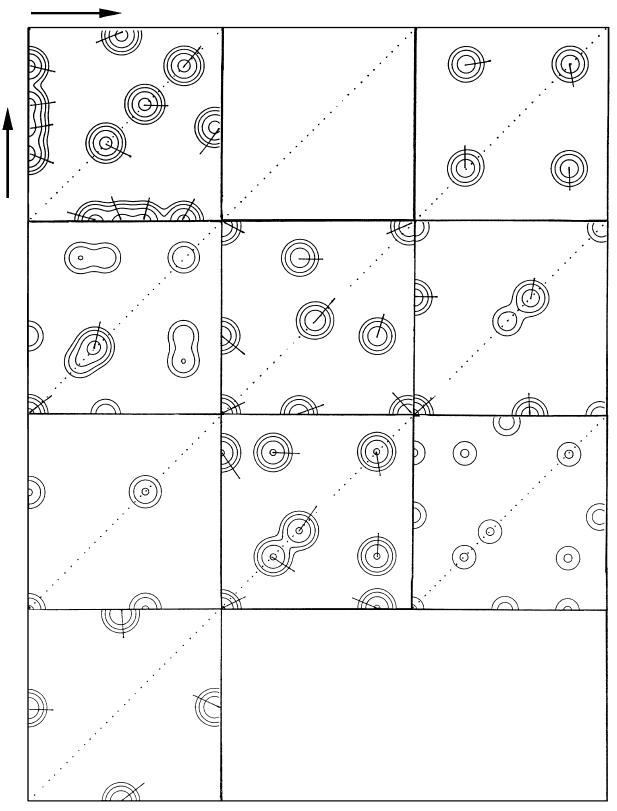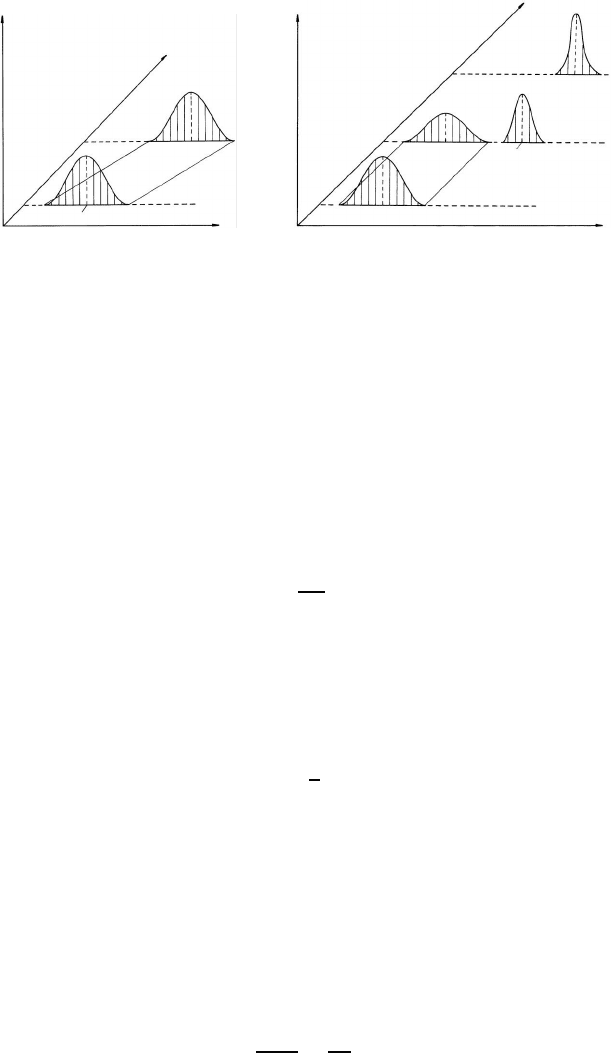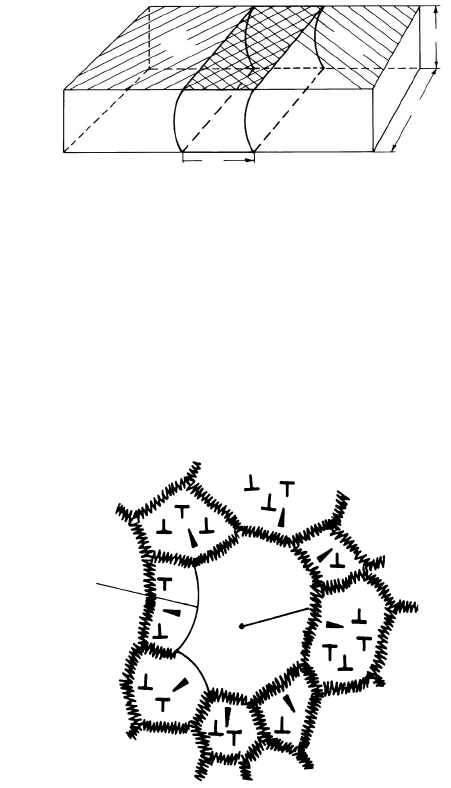Gottstein G., Shvindlerman L.S. Grain Boundary Migration in Metals: Thermodynamics, Kinetics, Applications
Подождите немного. Документ загружается.


536 6 Applications
Σ
15
Σ
5
Σ
17a
Σ
13a
Σ
25a
Σ
25a
Σ
11
Σ
15
Σ
5
Σ
9
Σ1
9a
Σ1
7a
Σ1
3a
Σ
23
Σ
21a
Σ
25b
Σ
23
Σ1
9b
Σ1
7a
Σ1
9a
Σ
9
Σ
9
Σ1
9a
Σ1
3a
Σ
21b
Σ
21b
Σ
17b
Σ
7
Σ
15
Σ
15
Σ1
3b
Σ
25a
Σ
11
Σ
25b
Σ
21b
Σ
25b
Σ
23
Σ
5
Σ
11
Σ
3
Σ
17b
Σ
15
Σ
17b
Σ
15
sample: Sigma Relationships
levels: 2 4 8 16
scatter-width: 2°
fmax: 21
sections: 5° [001]
sym.
[010]
[100]
FIGURE 6.20
Location of low Σ orientation relationships in Rodrigues space.
© 2010 by Taylor and Francis Group, LLC
6.2 Recrystallization annd Grain Growth 537
is mechanically stable. By heat treatment sufficient thermal energy is intro-
duced into the crystal to destabilize the dislocation arrangement. In principle,
there are two ways to remove the dislocations, or at least to reduce the stored
strain energy associated with the dislocations, namely recovery and recrystal-
lization. While recovery comprises all processes, which result in an annihilation
or rearrangement of dislocations in low energy dislocation structures, recrys-
tallization proceeds by generation and motion of grain boundaries, which are
capable of removing the swept-up dislocations. Therefore, while recovery will
locally rearrange and reduce the dislocation density, recrystallization will com-
pletely destroy the dislocation structure and rebuild a new strain-free crystal
arrangement. In the context of grain boundary migration, we shall focus on
recrystallization phenomena in the following.
Usually recrystallization proceeds from an abundance of recrystallization
nuclei and, therefore, the completely recrystallized material contains a high
density of grain boundaries. Owing to insufficient configuration entropy, grain
boundaries — like dislocations— also are not structural essentials of ther-
modynamic equilibrium and thus liable to be removed. As a consequence,
fine-grained recrystallized microstructures undergo grain growth, driven by
the increase in grain boundary energy. Grain growth can proceed in a contin-
uous or discontinuous way. During continuous grain growth, some grains will
shrink while others will grow, but the average grain size will grow while the
grain size distribution remains self-similar, i.e. normalized with the average
grain size the grain size distribution will not change upon continuous grain
growth (Fig. 6.21a). In contrast, during discontinuous grain growth, few grains
grow at the expense of the other non-growing grains. The microstructural evo-
lution bears a resemblance to the process of recrystallization and, therefore, is
referred to as secondary recrystallization. During discontinuous grain growth
a bimodal grain size distribution will develop and, thus, the self-similarity of
the grain size distribution is not maintained in this process (Fig. 6.21b).
There is a confusing variety of terms for the various microstructural changes
during heat treatment of deformed materials. The typical recrystallization pro-
cess during heat treatment of a cold worked metal is referred to as static pri-
mary recrystallization or short recrystallization. Sometimes it is also referred
to as discontinuous recrystallization, since it proceeds locally and thus does
not affect the entire volume concurrently. In contrast, continuous recrystalliza-
tion is not a real recrystallization process, but rather describes the phenomena
of very strong recovery, which also may result in the generation of large angle
grain boundaries. The term static recrystallization is used to distinguish the
two-step process, namely cold work and subsequent heat treatment, from the
recrystallization phenomena occurring concurrently with deformation at ele-
vated temperatures, which is referred to as dynamic recrystallization.
In contrast to the atomistic mechanisms of recrystallization the energetic
causes of recrystallization are relatively well understood. There is always a
driving force on a grain boundary, if — at a constant pressure and tempera-
ture — the displacement of the boundary reduces the Gibbs free energy G of
© 2010 by Taylor and Francis Group, LLC

538 6 Applications
frequency of grains of
a certain size
ln D
l
n
t
l
n
t
1
l
n
t
2
l
n
t
ln D
l
n
t
1
l
n
t
2
l
n
t
3
ln D
m,u
ln D
m
(a) (b)
frequency of grains of
a certain size
frequency of grains of
a certain size
frequency of grains of
a certain size
ln D
l
n
t
l
n
t
1
l
n
t
1
l
n
t
2
l
n
t
2
l
n
t
ln D
l
n
t
1
l
n
t
1
l
n
t
2
l
n
t
2
l
n
t
3
l
n
t
3
ln D
m,u
ln D
m,u
ln D
m
ln D
m
(a) (b)
frequency of grains of
a certain size
frequency of grains of
a certain size
FIGURE 6.21
Time dependence of grain size distribution for normal (a) and abnormal (b)
grain growth (schematic).
the solid. The reduction of Gibbs free energy by displacement of a boundary
element of size d
˜
A by the distance dx reads
dG = −Pd
˜
Adx = −PdV (6.31)
where dV is the volume swept by the boundary during its migration. The
quantity
P = −
dG
dV
(6.32)
is referred to as driving force. It is a free energy gain per unit volume, which
equivalently can be understood as a force per unit area of the boundary, i.e.
as a pressure on the boundary. The driving force for primary recrystallization
is the strain energy of stored dislocations. If these dislocations are consumed
by the moving grain boundary, then the driving force is given by
P = ρE
v
=
1
2
ρμb
2
(6.33)
where E
v
is the energy per unit length of a dislocation (μ — shear modulus,
b — Burgers vector).
With a dislocation density ρ =10
16
m
−2
, μ =5·10
4
MPa, and b =2·10
−10
m
the driving force amounts to about P = 10 MPa, which has been confirmed
by calorimetric measurements of the stored energy of cold work.
The driving force for grain growth is provided by the energy of the grain
boundaries. For discontinuous grain growth (secondary recrystallization) the
driving force reads
P =
3d
2
γ
d
3
=
3γ
d
(6.34a)
© 2010 by Taylor and Francis Group, LLC

6.2 Recrystallization annd Grain Growth 539
whereitisassumedthattherecrystallized and thus consumed grains comprise
cubes of size d and γ is the grain boundary energy per unit area. For a re-
crystallized grain size of d =10
−4
m and a grain boundary energy γ =1J/m
2
one obtains P =0.03 MPa. Obviously, the driving force for secondary re-
crystallization is smaller by orders of magnitude than the driving force for
primary recrystallization. Therefore, grain growth phenomena proceed much
more slowly or at much higher temperatures compared to recrystallization.
For continuous grain growth an element of a grain boundary feels the driving
force for migration by the curvature of the boundary. This curvature is due to
the fact that grain boundary triple junctions have to comply with the force
equilibrium of surface tensions. For 3D crystal arrangements it is impossible
to establish both planar grain boundaries and equilibrium conditions at the
triple lines or quadruple junction where grain boundaries meet. Therefore,
polycrystals are always liable to grain growth and particular measures have
to be taken to suppress grain growth, for instance, to maintain a station-
ary microstructure in metallic parts during high temperature service, e.g. of
turbine blades in jet engines. The driving force for continuous grain growth
reads
P =
2γ
R
(6.34b)
where R is the radius of curvature. Since the radius of curvature R usually
exceeds the grain size by about an order of magnitude, the driving force for
continuous grain growth is about an order of magnitude smaller than for sec-
ondary recrystallization.
Reference is sometimes made to a process termed tertiary recrystallization.
This usually occurs in thin sheets, when grain growth has ceased due to groov-
ing of the grain boundaries exposed to the sheet surface. In such a case, the
difference in surface energy γ
s
of the various grains acts as a driving force on
the grain boundaries, and this driving force may exceed the driving force for
grain growth, if the surface energy differentials Δγ
s
are large and the sheet
thickness h is small, since the driving force reads (Fig. 6.22)
P =
2Δγ
s
h
(6.35)
Forinstance,forΔγ
s
=0.1J/m
2
and a sheet thickness h =10
−4
m the driving
force P =2·10
−3
MPa. Since the surface energy can be modified by adsorp-
tion, the process of tertiary recrystallization depends on the atmosphere, and
by changing atmospheres it is even possible to invert the direction of grain
boundary motion.
6.2.2 Nucleation of Recrystallization
As previously mentioned, the deformed microstructure is mechanically stable.
To destabilize the dislocation arrangement after deformation three criteria
© 2010 by Taylor and Francis Group, LLC

540 6 Applications
dx
B
h
γ
1
s
γ
2
s
dx
B
h
γ
1
s
γ
1
s
γ
2
s
γ
2
s
FIGURE 6.22
Illustration of the driving force of tertiary recrystallization for γ
s
1
<γ
s
2
.
r > r
c
high angle
grain
boundary
pre-existing
nucleus
FIGURE 6.23
Schematic illustration of a recrystallization nucleus with growth potential in
a deformed structure.
© 2010 by Taylor and Francis Group, LLC

6.2 Recrystallization annd Grain Growth 541
have to be met (instability criteria (Fig. 6.23)).
Thermodynamic Instability
A nucleus can only grow if the total free energy decreases during expansion
of the nucleus. For this a critical nucleus size r
c
has to be exceeded
r
c
=
2γ
P
=
4γ
ρμb
2
(6.36)
Since the nucleation rate due to thermal fluctuations is much too small to
set off recrystallization, a supercritical nucleus must already be present in the
deformed microstructure. Usually, the deformation microstructure consists of
cellular arrangements, like dislocation cell structures or subgrain structures.
Thus, it is commonly assumed that there is a cell or subgrain of supercritical
size present in the microstructure to act as a viable recrystallization nucleus.
Mechanical Instability
Since the nucleus is embedded in a cellular arrangement of similar struc-
ture, there is not necessarily a net driving force on its boundaries for nucleus
growth; rather, it may also shrink or experience no net driving force at all
on its surface. An instability of the microstructure for recrystallization, there-
fore, requires that there is a net driving force for growth on at least part of
the surface of a nucleus. This can be achieved by an inhomogeneous dislo-
cation density distribution or a broad subgrain size distribution, which also
comprises large cells or subgrains. The latter can potentially be produced by
recovery.
Kinetic Instability
The most stringent requirement is, however, that the surface of the nucleus
must be a mobile grain boundary. As evident from Chapter 3, this requires
a large angle grain boundary. The generation of a mobile large angle grain
boundary in a deformed microstructure is the most difficult step for nucle-
ation of recrystallization. Potential mechanisms may be nucleation at preex-
isting grain boundaries, discontinuous subgrain growth in orientation gradi-
ents, deformation inhomogeneities with large misorientations and generation
of annealing twins, in particular annealing twin chains.
The requirement for concurrent compliance with all three instability criteria
strongly prefers nucleation in certain locations of the deformed microstructure,
in particular in deformation inhomogeneities (Fig. 6.24a) like shear bands or
microbands, or at preexisting large angle grain boundaries (Fig. 6.24b). An
exception is the formation of annealing twins, which by continued twinning
and thus generation of a twin chain (twin family) may produce a mobile large
angle grain boundary (Fig. 6.25). So far, observations have only confirmed
that twinning proceeds from a moving grain boundary, and thus already re-
quires the formation of a viable recrystallization nucleus.
© 2010 by Taylor and Francis Group, LLC

542 6 Applications
FIGURE 6.24
(a) TEM image of a recrystallized nucleus that developed near the edge of a
shear band and is growing into the deformed structure; (b) nucleation at the
grain edges of zone annealed aluminum.
1
1
1
10
10
10
a
ZR
a
FIGURE 6.25
Micrograph and {111} pole figure of a copper single-crystal after dynamic
recrystallization during a tensile test at 1103 K. ( −−−first-; −·−second-;
−··−third-generation twinning.)
© 2010 by Taylor and Francis Group, LLC

6.2 Recrystallization annd Grain Growth 543
2468100
0
0.2
0.4
0.6
0.8
1.0
fraction recrystallized x
time [10
3
s]
5.1%
350°C
2468100
0
0.2
0.4
0.6
0.8
1.0
fraction recrystallized x
time [10
3
s]time [10
3
s]
5.1%
350°C
5.1%
350°C
FIGURE 6.26
Recrystallized volume fraction as a function of annealing time following 5.1%
tensile deformation (after [581]).
6.2.3 Kinetics of Primary Recrystallization
The kinetics of recrystallization, i.e. the change of recrystallized volume frac-
tion X with annealing time t (Fig. 6.26) is determined by thermal activation
of the recrystallization mechanisms nucleation and nucleus growth. From nu-
merous experimental investigations, it is evident that the recrystallization
kinetics can be described by the Avrami-Johnson-Mehl-Kolmogorov equation
[578]–[580]
X =1−exp
−
t
t
R
q
(6.37)
In this equation q is the Avrami exponent and t
R
a characteristic time for
recrystallization, i.e. when 63.2% of the volume is recrystallized. In the case
of a constant and homogeneous nucleation rate
˙
N and isotropic growth rate
v the above equation can be derived as
X(t)=1−exp
−
π
3
˙
Nv
3
t
4
(6.38)
Comparing Eq. (6.38) with (6.37) the characteristic time for recrystallization
t
R
and the recrystallized grain size d
t
R
=
π
3
˙
Nv
3
−1/4
(6.39)
d =2vt
R
∼
=
2
3
π
v
˙
N
1/4
(6.40)
© 2010 by Taylor and Francis Group, LLC

544 6 Applications
Evidently, the recrystallized grain size is the result of a competition between
growth rate and nucleation rate. In contrast, the recrystallization time is a
joint effect of nucleation and growth, although very strongly dominated by
the growth rate. Apparently, the grain boundary migration rate, and thus
the grain boundary mobility, governs the kinetics of recrystallization and the
characteristics of the recrystallized microstructure.
6.2.4 Recrystallization Texture
6.2.4.1 Origin of Textures
The dominant deformation mechanism in metals is crystallographic slip by dis-
location glide. Crystallographic slip is a pure shear deformation and, therefore,
accompanied by rigid body rotation, which is the cause for the development of
deformation textures during cold work. Depending on material, temperature,
strain rate and, of course, strain, a specific deformation texture will be formed,
for instance, during rolling, which is the most common industrial forming pro-
cess. Interestingly, for a given rolling texture a defined recrystallization texture
develops upon annealing
4
. As an example, a conspicuously pronounced Cube
texture is found upon recrystallization of rolled copper (Fig. 6.27a,b). The tex-
ture is very sharp, almost like a single crystal. Equivalently, the typical brass
recrystallization texture develops from the brass rolling texture (Figs. 6.27c,d).
The respective orientations and their volume fractions are listed in Table 6.3.
There is also a specific texture development in bcc materials during annealing
of rolled sheet, for instance in ferritic steels (Fig. 6.28).
Because of the importance of recrystallization textures for commercial ap-
plications, such as industrial forming processes or electrical steels, there have
been considerable efforts to account for the formation of a recrystallization
texture from a given deformation texture. Since the process of recrystalliza-
tion comprises the stages nucleation and growth, theories were developed that
either attributed the recrystallization texture to the preference of special ori-
entations to be nucleated or the preference of special misorientations to grow,
i.e. to high mobility grain boundaries [582]–[584]. Extensive investigations into
this issue in the past 30 years have substantiated that there are many more
nucleus orientations than recrystallization texture components and also that
there is no growth competition among randomly disoriented grains. Rather,
it is now common belief that recrystallization textures are formed by growth
competition for a limited spectrum of nucleus orientations. Because of the
extreme sensitivity of the recrystallization kinetics on the growth rate, as evi-
dent from Eq. (6.38), essentially only the maximum growth rate misorientation
dominates the recrystallization texture development. Therefore, considerable
4
For ideal orientations of rolling and recrystallization textures in cubic crystals see Figs. 6.12
and 6.13 and Tables 6.1 and 6.2.
© 2010 by Taylor and Francis Group, LLC

6.2 Recrystallization annd Grain Growth 545
efforts were dedicated to a determination of the maximum growth rate mis-
orientation by so-called growth selection experiments [585].
TABLE 6.3
Pure Cu: Rolling Texture
ϕ
1
Φ ϕ
1
f (g
i
) M
i
σ
i
{hkl}uvw OR Name
Pure Cu: Rolling Texture
35 45 0 15.1 29.5 7.9 011 211 Brass-Def
62 33.5 63 18.5 42.1 7.4 123 634 S
90 32 45 16.9 25.5 8.4 112 111 Cu
90 80 45 5.5 2.8 6.7 255 511 Twin to Cu
0 21 0 4.1 1.8 5.6 025 100 Tilted Cube
Pure Cu: Recrystallization Texture
0 0 0 90.6 52.6 7.1 001 100 Cube
63 48 63 22.9 20.0 6.5 122 212 1
st
Twin to Cube
16.5 26 10.0 6.8 9.5 8.7 148 841 2
nd
Twin to Cube
76 29 74 6.6 9.5 9.3 148 747 2
nd
Twin to Cube
90 35 0 11.5 2.7 7.8 035 053 Tilted Cube
45 37 45 6.0 3.9 6.9 447 184 2
nd
Twin to Cube
Cu-22% Zn (Brass): Rolling Texture
32 45 0 13.8 65.2 13.2 011 211 Brass-Def
0 45 0 5.5 17.3 14.8 011 100 Goss
90 66 45 3.4 10.5 12.4 233 311 {223}
0 51 45 2.7 7.0 10.6 111 110 {111}
Cu-22% Zn (Brass): Recrystallization Texture
82 30 34 9.0 63.2 12.0 236 385 Brass Rex
90 33 0 4.4 8.9 10.4 035 053 Tilted Cube
0 20 0 2.7 8.1 11.6 025 100 Tilted Cube
45 38 68 2.5 18.5 12.1 134 132 –
0 0 0 1.2 0.3 7.8 001 100 Cube
Basic types of rolling and recrystallization textures in fcc metals:
M
i
— volume fraction; f (g
i
)—valueofODFatg
i
;
σ
i
— scattering amplitude; OR — name of orientation [590].
© 2010 by Taylor and Francis Group, LLC
